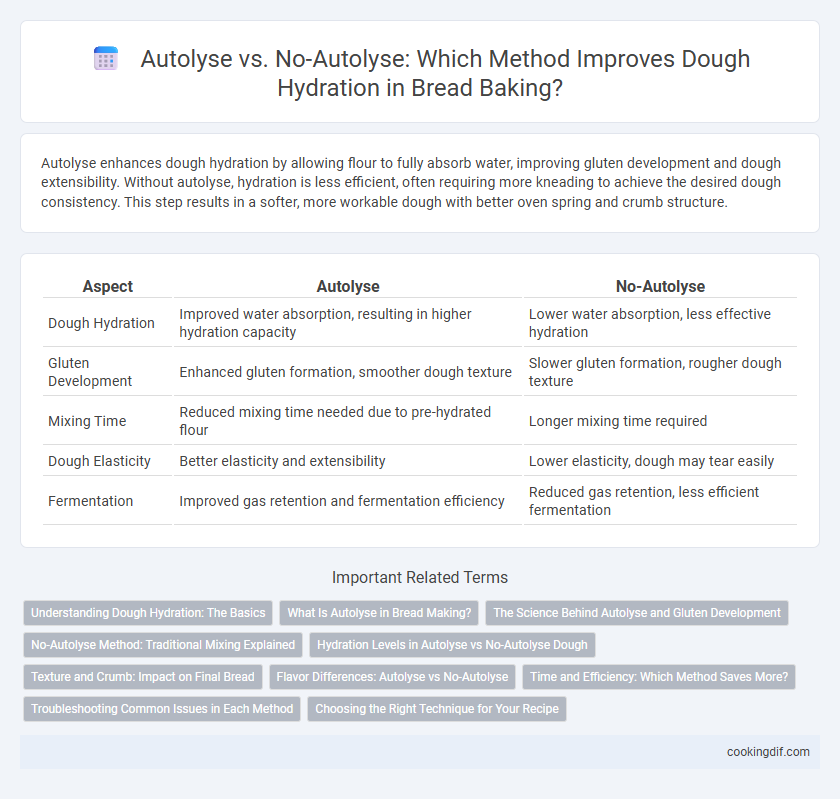Autolyse enhances dough hydration by allowing flour to fully absorb water, improving gluten development and dough extensibility. Without autolyse, hydration is less efficient, often requiring more kneading to achieve the desired dough consistency. This step results in a softer, more workable dough with better oven spring and crumb structure.
Table of Comparison
| Aspect | Autolyse | No-Autolyse |
|---|---|---|
| Dough Hydration | Improved water absorption, resulting in higher hydration capacity | Lower water absorption, less effective hydration |
| Gluten Development | Enhanced gluten formation, smoother dough texture | Slower gluten formation, rougher dough texture |
| Mixing Time | Reduced mixing time needed due to pre-hydrated flour | Longer mixing time required |
| Dough Elasticity | Better elasticity and extensibility | Lower elasticity, dough may tear easily |
| Fermentation | Improved gas retention and fermentation efficiency | Reduced gas retention, less efficient fermentation |
Understanding Dough Hydration: The Basics
Autolyse enhances dough hydration by allowing flour to fully absorb water, resulting in improved gluten development and dough extensibility without additional mixing. Without autolyse, water distribution can be uneven, leading to a stiffer dough and less optimal gas retention during fermentation. Understanding the role of autolyse in hydration is crucial for achieving a balanced crumb structure and efficient fermentation in artisan bread baking.
What Is Autolyse in Bread Making?
Autolyse in bread making is a mixing technique where flour and water are combined and rested before adding yeast and salt, allowing enzymes to naturally hydrate the flour and break down starches. This process improves dough extensibility, enhances gluten development, and promotes better hydration, resulting in a more elastic, easier-to-shape dough. Compared to no-autolyse methods, autolyse reduces mixing time and can improve crumb structure and flavor by facilitating enzymatic activity.
The Science Behind Autolyse and Gluten Development
Autolyse enhances dough hydration by allowing flour to fully absorb water before kneading, which activates enzymes that break down starches and proteins, facilitating better gluten development. This enzymatic process weakens the protein matrix, making gluten strands more extensible and easier to stretch, resulting in improved dough elasticity and gas retention. In contrast, no-autolyse methods mix ingredients immediately, limiting enzymatic action and often requiring more extensive kneading to achieve similar gluten structure.
No-Autolyse Method: Traditional Mixing Explained
The No-Autolyse method involves combining flour, water, salt, and yeast all at once, allowing the dough to hydrate simultaneously during mixing. This traditional mixing approach results in a shorter dough preparation time but may require more intensive kneading to develop gluten properly. Dough made without autolyse typically exhibits a different texture and fermentation pattern compared to autolyse dough, affecting crumb structure and hydration absorption efficiency.
Hydration Levels in Autolyse vs No-Autolyse Dough
Autolyse dough typically achieves higher hydration levels due to enhanced gluten development and starch absorption during the resting phase. No-autolyse dough often requires lower hydration to maintain structure, as gluten networks form solely during mixing. Studies show autolyse methods improve water retention, leading to softer crumb and better extensibility in bread.
Texture and Crumb: Impact on Final Bread
Autolyse enhances dough hydration by allowing flour to fully absorb water, resulting in a more extensible dough with improved gluten development, which leads to a tender crumb and open texture. Doughs without autolyse often have tighter, denser crumbs and a chewier texture due to less optimal hydration and gluten structure. The autolyse method promotes a lighter, more airy crumb, enhancing the overall mouthfeel and softness of the final bread.
Flavor Differences: Autolyse vs No-Autolyse
Autolyse enhances dough hydration by allowing flour to fully absorb water, leading to improved gluten development and deeper flavor complexity. No-autolyse dough often results in a less aromatic crumb, as enzymatic activity that promotes fermentation and flavor precursors is reduced. This process contributes to a richer, nuttier taste in autolysed bread compared to the more straightforward flavor of no-autolyse loaves.
Time and Efficiency: Which Method Saves More?
Autolyse significantly reduces dough mixing time by hydrating flour and activating enzymes before salt and yeast addition, leading to improved gluten development and easier kneading. Without autolyse, dough requires longer mixing and kneading periods to achieve proper hydration and structure, increasing overall preparation time. The autolyse method saves efficiency by decreasing active mixing time and enhancing dough extensibility, resulting in faster fermentation and better dough handling.
Troubleshooting Common Issues in Each Method
Autolyse improves dough hydration by allowing flour to fully absorb water, reducing mixing time and enhancing gluten development, but may cause over-relaxation leading to slack dough if timing is excessive. No-autolyse methods require longer mixing to hydrate flour, often resulting in inconsistent dough texture and increased oxidation, which can cause dull crumb color. Troubleshooting autolyse involves careful timing to prevent over-hydration, while no-autolyse troubleshooting focuses on optimizing mixing duration to achieve proper dough consistency without overworking.
Choosing the Right Technique for Your Recipe
Autolyse enhances dough hydration by allowing flour to fully absorb water, improving gluten development and dough extensibility. No-autolyse methods require longer mixing times to achieve similar hydration, risking over-oxidation and reduced flavor complexity. Selecting autolyse or no-autolyse depends on desired dough texture, fermentation time, and recipe specifics such as flour type and hydration percentage.
Autolyse vs No-Autolyse for dough hydration Infographic

 cookingdif.com
cookingdif.com